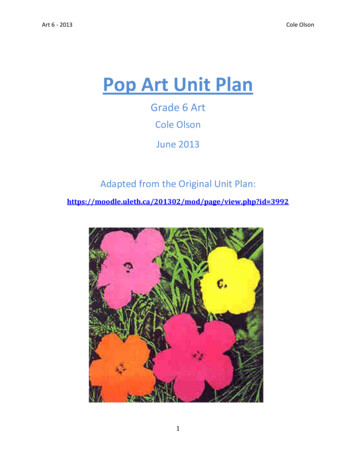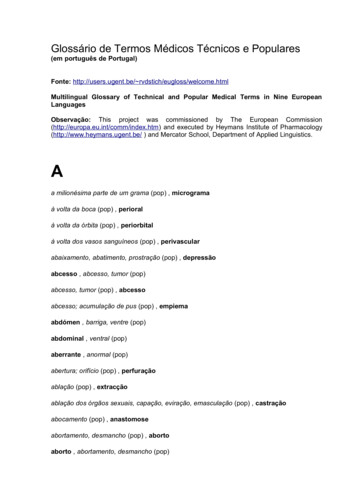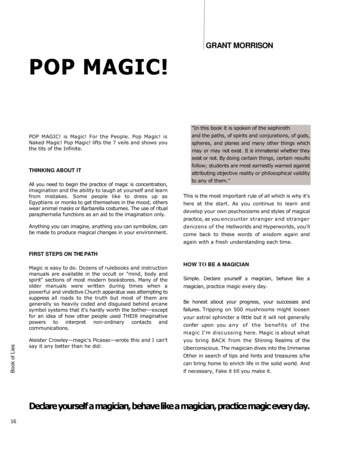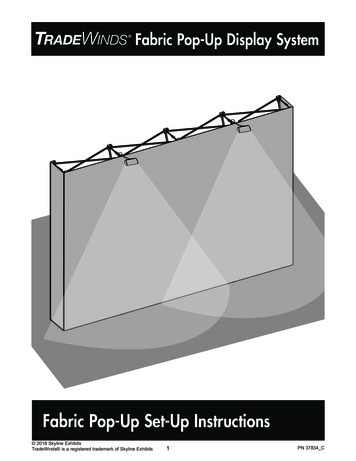
Transcription
Art 6 - 2013Cole OlsonPop Art Unit PlanGrade 6 ArtCole OlsonJune 2013Adapted from the Original Unit php?id 39921
Art 6 - 2013Cole OlsonTable of ContentsUnit OutcomesPage 3Unit RationalePage 4Essential Questions and Enduring UnderstandingsPage 5Unit Assessment PlanPage 7Lesson SummariesPage 8Lesson Plan 1Page 9Lesson Plan 2Page 11Lesson Plan 3Page 13Lesson Plan 4Page 15Lesson Plan 5Page 17ResourcesPage 192
Art 6 - 2013Cole OlsonUnit OutcomesGeneral Learning Outcomes:Elementary Art Level 3 (Grade 6)ReflectionASSESSMENT: Students will impose standards on designed objects and invent improvedversions.APPRECIATION: Students will interpret artworks for their symbolic meaning.DepictionMAIN FORMS AND PROPORTIONS: Students will modify forms by abstraction, distortionand other transformations.QUALITIES AND DETAILS: Students will employ surface qualities for specific effects.CompositionEMPHASIS: Students will create emphasis through the use of structural devices andstrategies.UNITY: Students will create unity by integrating the parts of a composition into the whole.ExpressionPURPOSE 1: Students will record or document activities, people and discoveries.PURPOSE 2: Students will illustrate or tell a story.PURPOSE 4: Students will express a feeling or a message.PURPOSE 5: Students will create an original composition, object or space based on suppliedmotivation.3
Art 6 - 2013Cole OlsonUnit RationaleThis unit was originally planned for a grade 6 curriculum, so I decided to keep lessonsaimed towards the same grade level. After reviewing the grade 6 program of study, Idecided to include some more general learning outcomes to steer the idea of pop art in adirection that reflected the objectives of the curriculum. My main motivation for selectingthis unit was to reformat the content into a more clean and precise unit plan. Upon firstreviewing the lessons, I could see that there were some good activities and lesson ideasthat were losing potential due to a poor format. I believe my additions of artwork, activitiesand tweaking of lessons, in particular the third lesson, helped to create a well rounded andinformative look at pop art.This unit was an interesting subject to approach, as grade 6 is an age for students to startlooking at the world around them more closely and picking up on elements of pop culture. Ibelieve the lessons and activities originally planned offered a gentle easing into the idea ofpop culture without overloading students with definitions and theories, and because of thisI felt the content was successful and did not want to tamper with the ideas to greatly. Atfirst I was nervous to approach grade 6 students with such complex ideas and freedom tocreate, but the more I looked at the lessons the more I began to like the idea of havingstudents explore their own interests in pop culture. I believe students in grade 6 will allhave very different exposures to pop art, and I think the lessons in this unit will allow allstudents to work at a level that is comfortable to them.This unit also had some great room for summative assessment with its diverseassignments, and for this reason I believe it was a strong unit worth creating. I would liketo try this unit with a large group of students from diverse backgrounds to see what kind ofdifferences in ideas students have about pop art. Pop art is as relevant today as it was whenit was first created, and I believe it is an important unit worth studying. As students ingrade 6 are being introduced to the ideas of pop culture, I think it is a good age for studentsto start exploring ideas in art that relate to advertisement and pop culture.4
This unit wasoriginallyArt 6designed- 2013for both grade 8and 9, b,Established GoalsStudents will:- Learn about pop art.- Learn about theorigins of pop art.- Learn about theimportant figures inpop art.- Examine differentexamples of pop art.- Learn aboutcomplimentarycolours.- Learn how to applysymbols to artwork.- Learn how to create atheme in artwork.- Learn how to createunity in a collage.- Learn how to takecriticism.- Learn how to givecriticism.- Understand theimportance of pop artas an important artform.Cole OlsonEssential Questions and Enduring UnderstandingsStudents will explore art through reflection, depiction, composition and expression to givestudents a complete set of experiences in art.MEANINGEnduring Understandings:Students will understand that U1 – Pop Art is an important andmeaningful art form.U2 – Pop Art has a wide variety ofexamples and rich history.U3 –Symbols can be used to create meaningin an art work.U4 – Common themes can be created andfound in similar art works.U5 –Meaningful critique help artist growtechnically and creatively.U6 – Colour and texture can create meaningin pop art.Essential Questions:Students will keep considering Q 1– How do artists generate ideas of theirartwork?Q2 – How is pop art unique from other art?Q3 – What are the different techniques thatare used in pop art?Q4 – How do artists critique their workand other’s artwork in a meaningful way?Q5–What artists have influenced pop art?ACQUISITION OF KNOWLEDGE & SKILLSStudents will know Students will be skilled at Complimentary colours can be used tocreate attractive images.-Pop art can be derived fromadvertisement.-Symbols can be used to convey meaning.-Themes can be distinguished betweendifferent art works.-How to properly critique their own workas well as others.5Using Complimentary colours.Mixing Colours to create adesired result.Finding themes in works of art.Creating meaning thoughsymbols.Using pop art techniques tocreate art.Enhancing art critique with basicart vocabulary.
Art 6 - 2013Cole OlsonSTAGE 2: EvidenceAssessment EvidenceStudents will need to show their learning by:2 – EvidenceEvaluative CriteriaPerformance is judged in terms of – CritiqueShowcasing their paintings in a final critiqueand explaining the elements they used.Participation:- class demonstrations- project work- Sketchbook brainstorming- Pop art vocabulary- Reflection on art work- Critique of peer’s workTransfer Task: The students will show theirlearning by sketching, class discussions,practicing and working pop art techniquesthrough pop art advertisement, text art,collaging, and symbols.Completion: craftsmanship, proper use oftechniques, clean appearanceCreativity: ability to create unique andoriginal ideas and meanings using pop arttechniquesCritique: reflections on own art work andcritique of peer work.6
Art 6 - 2013Cole OlsonUnit Assessment PlanMethod ofAssessmentTool for AssessingWeightingTypeCritiques and Checklistn/aFormativeWord ArtAssignmentObservations15%SummativePop ArtAdvertisementRubric15%SummativeResponse Pop ArtImageRubric20%FormativeSymbol ArtworkRubric20%Collage ArtworkRubric30%SummativeSummativeStudents will be evaluated on the standard 5 point scale as seen in the Elementary ReportCard (5 - Excellent, 4 - Very Good, 3 - Satisfactory, 2- Improvement Needed,1 - Unsatisfactory)7
Art 6 - 2013Cole OlsonLesson Plan Summaries Lesson Summary 1In this lesson the students will learn what pop art is and where it originates from. They will goon to learn about different techniques used in pop art, such as colour mixing andcomplimentary colours. Students will then create word art by creating block letters with abackground and use complimentary colours to give the letters a pop art look.Lesson Summary 2Students will learn how advertisement and pop culture have similarities between them, andwill focus on different advertisement artworks by famous pop artists. They will then usepencils and colours to recreate products and logos as closely to the originals as possible tocreate their own pop art advertisements.Lesson Summary 3In this lesson students will learn about how different images can have similar themes in themto create unity between images. They will look at a variety of images and try to determine thesimilar theme between them. Students will then create a third piece of pop art to match thetheme of two provided pieces of pop art to understand how to match theme in artworks.Lesson Summary 4Students will learn about symbols and icons, and learn how to create meaning though symbolsin their artwork. Students will begin by selecting an object to act as an important symbol tothem, and draw it out in 4 different perspectives. Afterwards, students will create a piece ofpop art to convey meaning through the symbol they have chosen.Lesson Summary 5In this lesson students will learn what collaging is and how to use different small pieces tocreate a unified piece of art. They will then use either a symbol or a theme amongst theirindividual components in their individual components to create a unified collage. Students willsubmit their collage to show an understanding of all pop art techniques talked about in theunit.8
Art 6 - 2013Cole OlsonLesson 1 – Ordinary Words Made ExtraordinaryGeneral Learning Outcomes:Students will explore art through reflection, depiction, composition and expression to givestudents a complete set of experiences in art.Specific Learning Outcomes:Students will understand what pop art is and its importance in art history, and will learn how tocreated pop art effects using text and complimentary colour.Students Will:-Understand how to visually portray feelings and moods.Understand how color affects mood of the viewer.Understand how the feelings of a viewer can be affected by the colours used.Show interest and enthusiasm for art.Assessment:-Formative: Observation, Class discussionSummative: Word Art AssignmentMaterials: Sketchbooks, Paper, Pencils, Pencil crayons, Markers, RulerEncounter:Students will begin this unit by talking as a group about what pop art is and why it is animportant movement worth studying. Students should be informed firstly about what popart is. Have students pick a page in their sketchbooks to write down information so theycan use it for reference later. After the definition of pop art has been discussed, talk aboutwhere and when pop art originated, and from there talk about some of the leading artists inthe movement. For this class, focus attention on Andy Warhol and Lichtenstein. Show theclass the following images and ask them the following questions:What are some similarities between these pictures? What are the differences? How did theartists create these images? How would you make this image?9
Art 6 - 2013Cole OlsonACTIVITYStudents will create text on a page in their sketchbooks using complimentary colours andbackground art. Students will begin by examining the colour wheel and looking at the threeprimart colours (red, blue, yellow) and discussing how they make the secondary colours(orange, green, purple). From there students will learn about complimentary colours, andhow the opposite sides of a colour wheel contain colours that work well together becauseof their differences. The following can be used for reference:After students learn about complimentary colours, give the following instructions:1. Think of some common words that are four to six letters long. Come up with a list of 10words and write them on a piece of paper.2. Select one of these words, and in your sketchbook carefully print out the word in largebolded letters. Try and take up as much of the paper as possible.3. Create an atmosphere for your word by creating a symmetrical image behind the word,making sure that the image is equal on both sides. This background should not overpowerthe drawing of the word, but add to it.4. Using complimentary colours, colour in your word one colour and the background the othercolour.5. Finish the letters in your word by outlining them with a dark black marker.6. Have students write on a new page in their journals about why they chose the word theydid. Students should also comment on the colours they used and the effect they create. Thispiece of art will later be collected to be graded for summative assessment.Closure:Students will end the class by each presenting their pop art advertisements and talkingabout the choices they made that transformed them from the original image to their ownpiece of art. Students can also present their images in an advertising format with a salespitch for the product as well to add to the illusion of the advertisement.10
Art 6 - 2013Cole OlsonLesson 2 – Advertising as ArtGeneral Learning Outcomes:Students will explore art through reflection, depiction, composition and expression to givestudents a complete set of experiences in art.Specific Learning Outcomes:Students will understand the connections between advertisement and pop art, and makeconnections between pop art of the 1960’s and their own experiences with advertisement.Students will use drawing skills to create their own pop art advertisement.Students Will:-Recreate images accurately using drawing techniques.Simplify images to create abstraction.Express meaning through the choices in their artwork.Use supplied motivation to create an original composition.Assessment:-Formative: Observation, Class discussionSummative: Pop Art AdvertisementMaterials: Sketchbook, pencils, pencil crayons, markers, ruler, newspapersEncounter:Students will begin this unit by talking as a group about how pop art relates to advertising.Students should discuss where they have seen different advertisements in their lives, andtry brainstorming as many different advertisements as they can. Have students talk aboutwhat advertising means to them. To introduce the history of pop art and advertising, talk tostudents about its history in the 1960’s, and some of the common themes that started toemerge in these pieces of art (simplicity, appropriated images). Have students look at thefollowing images below and start a classroom discussion on the following questions:What do you see in the following images? What are their similarities? How would youcreate these images? What do you think the artists wanted to say with these images?11
Art 6 - 2013Cole OlsonACTIVITYStudents will take advertisements from magazines and newspapers and recreate them asclosely as possible to create their own pop art advertisements. Have students individuallypick out a newspaper advertisement that they will recreate. Encourage students to pick abrand name logo to work off of. Students can pair up and both use the same logo, but eachmust create their own pop art advertisement. Students will be given the followinginstructions:1. On a new piece of paper in their sketchbooks, students will draw lightly using pencilthe outline and details of the advertisement they have chosen. Ensure that studentsare referencing their advertisements constantly to ensure their own pop artrenderings are as authentic to the original as possible. Students must show theirsketch to the teacher before they can continue with the rest of the picture.2. To add to the image’s overall look, have students first darken in all lines and theimage itself to prepare It for the colouring stage.3. Again referencing the original advertisement, have students use coloured pencils toaccurately add the same colour to the image to finish their pop art advertisement.This advertisement will later be used as a piece of summative assessment.Closure:Students wishing to share can showcase their work and comment on the choices they maderegarding the colours they used and the words they picked. Encourage students to talkabout the reflections they have written in their sketchbooks, as it will help them to talkabout the art they have created.Sponge Activity:Students who finish early will start on a new piece of paper a second pop artadvertisement. This time, give students a copy of Andy Warhol’s Campbell’s Soup and havethem recreate the image using the same technique as before. This will help students reactto a given stimuli and learn more about pop art stars like Andy Warhol by examining hiswork.12
Art 6 - 2013Cole OlsonLesson 3 – Cropping and Combining ImagesGeneral Learning Outcomes:Students will explore art through reflection, depiction, composition and expression to givestudents a complete set of experiences in art.Specific Learning Outcomes:Students will combine elements of pop culture that they have experienced and learned about torespond to a visual example with their own original artwork.Students Will:-Utilize art techniques involving painting, drawing, collage and pop art.Create artworks with a common idea or theme.Create an original piece with no outside motivation to guide decisions.Assessment:-Formative: Observation, Class discussionSummative: Response Pop Art ImageMaterials: Sketchbook, pencils, pencil crayons, markers, ruler, paints, paint brushesEncounter:Students will begin this unit by talking as a group about the techniques of pop art they haveseen so far, and begin looking at more artists that fall into the category. The art of JamesRosenquist, Ed Ruscha, and Robert Rauschenberg can be seen below, and should be used tolead the class’ discussion. Have students talk about the paintings and artworks below, anduse the following questions to lead the class discussion:What do you see in the following images? What are their similarities? Do these artworks fittogether, or are they all too different? What is common about the artist’s work? What is themessage they are trying to convey? What could you create that would go with thesepictures to make a common theme?13
Art 6 - 2013Cole OlsonACTIVITYStudents will create an image that will complete a set of three common themed pieces. Theother two pieces will be given to the students as the stimuli, and students will have tocreate the third image to complete the set of three. The third picture can be done using anymedium including pencils, crayons, paints, collages and other art forms, but must have asimilar theme to the other two images. The two images to help students decide upon thethird will be:Start by having students discuss as a class possible themes between the two pictures. Drawattention to colours and the content of the pictures in order to start generating ideas. Aftereveryone has discussed the pictures, have them begin to plan out their third drawing. Thisdrawing should be done on a new piece of paper in their sketchbooks. After students havecompleted their drawings, have them reflect on another page in their sketchbooks. In theirreflections, students should describe what they created, why they created the image theydid, and how their image ties in with the other two images given to them.This third image will be used for summative assessment.Closure:The class will close by having students present their artwork to the rest of the class, andpost their work on a wall with the original two pieces of art in the center. This will give thestudents a chance to see all of their classmate’s creations, as well as see how all of theartworks work together to create a common theme throughout.14
Art 6 - 2013Cole OlsonLesson 4 – Symbols of Ordinary LifeGeneral Learning Outcomes:Students will explore art through reflection, depiction, composition and expression to givestudents a complete set of experiences in art.Specific Learning Outcomes:Students will understand the connections between advertisement and pop art, and createmeaning though objects and advertisement. Students willStudents Will:-Distort shape and line to achieve desired effects.Understand that the arrangement of forms into shapes and design can capture a viewer’sinterest and give meaning to art.Learn how to create transitions between colour, texture and tone to create a unified piece.Assessment:-Formative: Observation, Class discussionSummative: Symbol ArtMaterials: Sketchbook, pencils, pencil crayons, markers, rulerEncounter:Students will begin by discussing what icons and symbols are, and brainstorming symbolsthat they can think about from everyday life. Get students to then think about shoes, andcome up with some ideas that shoes might symbolize. Have a image of shoes and see whatkind of responses students give about their meaning to the image:What do you see in the following image? How are shoes a symbol for life and a subject ofstill life? Have students begin to think about how advertisement looks at what peopleexperience every day, and how they promote these items. From there, introduce the ideathat pop artists use these popular objects as subjects for their artwork, often too achieve aspecific purpose. Items such as soup cans, hot dogs and billboards are just a few examplesof how pop artists use advertisements to create works of art.15
Art 6 - 2013Cole OlsonACTIVITY 1:Students will begin by selecting a popular item that will be the basis of their sketches.These items should have a special meaning for students, whether it be something fromtheir lives or something that they have a past experience with. Give students the followingdirections:1. Students will select a new page in their sketchbooks and divide them in to 4different sections.2. Students will lightly sketch the object they have chosen from 4 differentperspectives in each of the four sections. One should be a right view, one a left view,one and top view, and one a front view.3. Students will then explain why they picked the object they did, and why the objecthas importance to them.This activity should take at least one class, and will be used for formative assessment.ACTIVITY 2:The same object that students used for their sketches will next be used for a pop art image.This object should be something that is important to each student, and this object shouldact as a symbol for a person, certain time or a way of life. Students will create their pop artand emphasize the symbol they are using through the use of colour, texture, and othervisual elements. This artwork should be planned so that the symbol each student haschosen is the central point of focus in the image. The meaning of the symbol should bemade clear by the elements used in the artwork. If needed, go over symbols and icons againwith the class to ensure that students are creating appropriate artwork.This piece of art will be used as summative assessment.Closure:Students will finish the assignment by writing a brief description of what they chose astheir symbol in their sketchbooks, and how they used different art techniques to promotethe symbol and make its meaning clear.Sponge Activity:Students who finish early should return to their sketchbooks and try and sketch outanother symbol that has meaning to them in four different perspectives. This time,encourage students to take more risks and chose an object that is more abstract of asymbol, but still means something to them.16
Art 6 - 2013Cole OlsonLesson 5 – CollagingGeneral Learning Outcomes:Students will explore art through reflection, depiction, composition and expression to givestudents a complete set of experiences in art.Specific Learning Outcomes:Students will understand the connections between advertisement and pop art, and makeconnections between pop art of the 1960’s and their own experiences with advertisement.Students will use drawing skills to create their own pop art advertisement.Students Will:-Learn new ways to use drawing materials.Determine how an artwork’s form is composed of small components that make a whole.Learn how meaning of an artwork can be altered by artistic style.Learn how to accept and supply constructive criticism for peer’s artwork.Assessment:-Formative: Observation, Class discussionSummative: Collage ArtworkMaterials: Sketchbook, pencils, pencil crayons, markers, magazines, newspapersEncounter:Students will begin by discussing the ideas behind collaging. Ideas like juxtaposing imagesand text layering should be discussed, and students will be asked to write these definitionsdown in their sketchbooks. Begin by brainstorming what kinds of materials can be used tocreate collages, and have students think about abstract pieces and how they might be usedto create a collage. Have students examine the collage by Raushenberg and brainstormwhat materials were used to create the artwork:After the discussion, revisit the idea of symbols and have students find ideas of how toincorporate symbols and icons into collage work.17
Art 6 - 2013Cole OlsonACTIVITYStudents will first come up with a common theme or symbol that they would like to focustheir collage around. Students should be reminded of the idea of themes and symbols fromthe last two lessons, and they should use these ideas to create a unified collage out of manydifferent parts. Students will be given the following instructions:1. Students will sketch out ideas on a page in their sketchbooks that contain thoughtfuldecisions about the symbol or themes they have chosen for their collage.2. When students are done with their sketches, they will show their work to theteacher and will be given permission to continue to a good copy. If changes need tobe made, they will be required to make any adjustments needed before continuing.3. Students will create a good copy on a new page in their sketchbooks. Students willbe given magazines and newspapers to take images out of and add to their work.This assignment will be handed in to be used as summative assessment once completed.Closure:Students will finish the assignment by writing a brief description of what they chose astheir symbol or theme of their collage in their sketchbooks on a new page. Students willalso comment on how they used different parts to create an entire unified composition, andtalk about what materials they used in order to do so.18
Art 6 - 2013Cole OlsonResourcesTaken from the original lesson plan derived php?id 3992Lesson 1:Rushca, Ed. Flash, L.A. Times. 1963Rushca, Ed. Talk about Space. 1963Lesson 2:Warhol, Andy. Campbells Soup Can.Ramos, Mel. ChiquitaLesson 5:Lichtenstein, Roy. Whaam. 1963Lichtenstein, Roy. Big Painting. 1963Warhol, Andy. PopeyeLesson 6:Rauschenberg, Robert. Estate. 1963Rosenquist, James. F-111. 196519
U1 - Pop Art is an important and U2 -Pop Art has a wide variety of examples and rich history. U3 -Symbols can be used to create meaning in an art work. U4 - Common themes can be created and found in similar art works. U5 -Meaningful critique help artist grow technically and creatively. -Colour and texture can create meaning in pop art.










